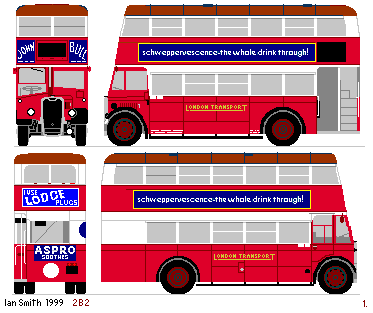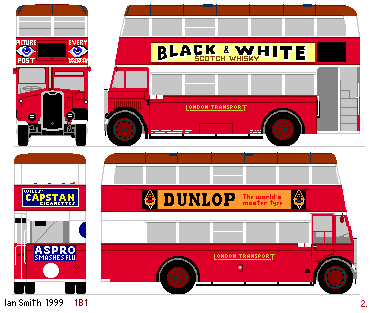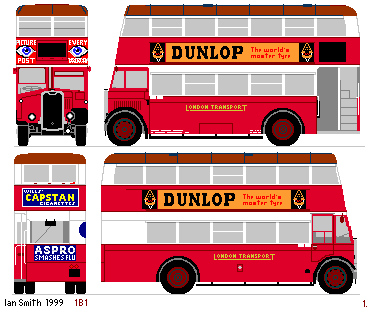
The LONDON TRANSPORT B classThis page created 12th March 1999, by Ian SmithLondon Transport had never been a user of Bristol buses, and probably would never have had the opportunity but for World War 2. During that conflict all bus production was controlled by the Ministry of War Transport. Thus AECs were allocated to traditional Bristol users, Bristols went to AEC/Leyland users, Leylands went to hardly anyone, and Guys, from a company that had not made buses for some time, went to just about everyone. This ensured that no-one had an unfair advantage by having holdings of suitable spares or expertise. The 1B1 classBut in 1942 London Transport was offered the chance to buy just nine "unfrozen" Bristol chassis, with Gardner 5 cylinder engines, to be fitted with Park Royal utility bodywork. Although the Bristol chassis was produced to the design philosophy of the Tilling group, which went for hard-worked small engines and crash gearboxes, distinct from London's policy of large engines working well within their capacity working through fluid flywheels and preselector gearboxes, the offer was accepted.
The body, standing 14ft 6in high in accordance with the Ministry specification, was higher than the London maximum (14ft 3.25in), and restricted which garages they could be used at.
The Bristol K5G chassis were fitted with Gardner 5 cylinder diesel engines
driving through a crash gearbox and dry-plate clutch. The engine was bolted direct to the chassis,
so they were NOISY. They also gave their passengers vibration massages!
But they were fairly responsive, light at just 7tons, and (apart from the noise),
fairly reasonable to drive.
Into ServiceThey emerged from Park Royal and went to Chiswick for the final trimmings (such as side route information blind apertures) before going into service from May 1942. They were all allocated to Hanwell garage (HW), which already had experience of Gardner engines in its LT allocation. The nine buses spent their entire LT careers at Hanwell Garage, working on route 97 (Brentford - Greenford - Ruislip), and later route 92/A (Hanwell Garage - Wembley Empire Pool/Trading Estate).
They were overhauled just after the war, when they acquired extra opening windows,
but went back to their familar route afterwards.
With the end of the war they also regained proper headlights,
albeit very small ones that looked lost in the large cab-front dimple,
plus spotlights. The white rims to mudguards and bodywork vanished too,
followed some time later by the rear white spot.
RebuildAutumn 1948 saw the start of another round of overhauls, that produced substantially greater changes. The Gardner engines were removed, to provide spares for the Guys, and were replaced by a modified AEC 7.7 litre engine like those in the 2B2s. This made them K6As rather than K5Gs, but they retained their old-fashioned very-high radiators. They also received glazed rear emergency exits, and postwar style blinds. A small livery variation was the painting of the downstairs window sills white instead of red.WithdrawalAs K6As they lasted until the end of 1951, when withdrawals started. The last, B5, was withdrawn in February 1953. The whole sub-class was sold for further service within the Tilling group, most of the 1B1s going to Crosville, except B5 which went to United for the new tram-replacement services for Hartlepool. Most of the Crosville examples were quickly rebodied.
The 2B2 class The second batch of Bristols came in different circumstances: in late 1943,
although the return of the Allies to Europe was still to come,
people were looking forward to the end of the war and a return to peace-time production.
There was a suggestion that some Bristol buses might be produced,
even though the Bristol manufacturing was still busy with aircraft production.
The Tilling group rejoiced, but not for long:
these Bristols were to have AEC engines!
The Tilling group was now reluctant,
but London Transport decided that they would rather have AEC engined
Bristols than more Guys.
Tillings suggested that the AEC engines might go in the Guys,
releasing Gardner engines for them to enjoy in the Bristols.
But the AEC engines would not fit.
Once again the men from the Ministry reminded all the players
that They determined who was offered what.
The second batch of Bristols came in different circumstances: in late 1943,
although the return of the Allies to Europe was still to come,
people were looking forward to the end of the war and a return to peace-time production.
There was a suggestion that some Bristol buses might be produced,
even though the Bristol manufacturing was still busy with aircraft production.
The Tilling group rejoiced, but not for long:
these Bristols were to have AEC engines!
The Tilling group was now reluctant,
but London Transport decided that they would rather have AEC engined
Bristols than more Guys.
Tillings suggested that the AEC engines might go in the Guys,
releasing Gardner engines for them to enjoy in the Bristols.
But the AEC engines would not fit.
Once again the men from the Ministry reminded all the players
that They determined who was offered what.
London Transport ended up with just twenty, AEC engined Bristol chassis with Duple bodies, B10-B29. Although the Duple bodies were not very different in outline from the Park Royal design, these buses had a much more modern appearance, due mainly to the low-set and shapely K6 radiator. There were other differences too: more opening windows at the sides; plain front windows without hopper ventilators; a simpler dash panel; headlights and spotlight; a roof without a peak at the front. Small details, but adding up to a much less stark appearance. With some aluminium incorporated in the chassis, they were lighter too, by half a ton. This, with the 7.7 litre engine gave a much quieter and smoother ride, and a revolution in performance. THESE utilities did not need to be thrashed to meet ordinary schedules. Into ServiceThe completed buses arrived after the war, at the end of 1945, going into service from mid-December. They joined the K5Gs at Hanwell garage, soon to be renamed Southall (HW) in July 1950, to distinguish it more clearly from Hanwell Trolleybus Depot (HL). They worked the 92/A (Wembley Empire Pool/Trading Estate - Hanwell Garage) as well as appearing alongside the earlier Bristols on the 97 and making forays on the 83 (Golders Green - Hayes Station).After LondonTheir London careers were cut short by the advent of the RTs and the quick deterioration of their bodywork. They were withdrawn from service between September 1951 and April 1953. All were sold for further service, some before they had finished work in London! They went to Crosville, Lincolnshire (which lost two to United for use in Hartlepool) and Brighton, Hove and District (which also lost one to Hartlepool). Many were rebodied with new ECW bodies from Lowestoft, making them identical in appearance to the standard Tilling product.
|
 The nine chassis began to arrive at the end of January 1942,
and went to Park Royal for bodies almost identical to those
already designed for the prototype utility buses,
the
The nine chassis began to arrive at the end of January 1942,
and went to Park Royal for bodies almost identical to those
already designed for the prototype utility buses,
the 
 Bus Stop
Bus Stop London Bs
London Bs bus histories
bus histories